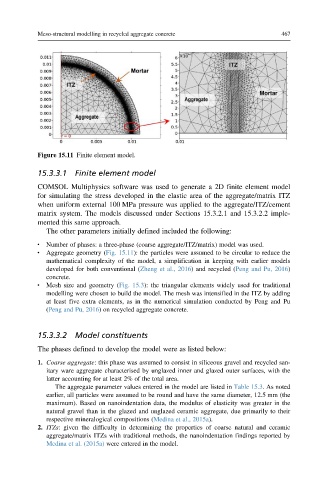Page 519 - New Trends in Eco efficient and Recycled Concrete
P. 519
Meso-structural modelling in recycled aggregate concrete 467
Figure 15.11 Finite element model.
15.3.3.1 Finite element model
COMSOL Multiphysics software was used to generate a 2D finite element model
for simulating the stress developed in the elastic area of the aggregate/matrix ITZ
when uniform external 100 MPa pressure was applied to the aggregate/ITZ/cement
matrix system. The models discussed under Sections 15.3.2.1 and 15.3.2.2 imple-
mented this same approach.
The other parameters initially defined included the following:
Number of phases: a three-phase (coarse aggregate/ITZ/matrix) model was used.
Aggregate geometry (Fig. 15.11): the particles were assumed to be circular to reduce the
mathematical complexity of the model, a simplification in keeping with earlier models
developed for both conventional (Zheng et al., 2016) and recycled (Peng and Pu, 2016)
concrete.
Mesh size and geometry (Fig. 15.3): the triangular elements widely used for traditional
modelling were chosen to build the model. The mesh was intensified in the ITZ by adding
at least five extra elements, as in the numerical simulation conducted by Peng and Pu
(Peng and Pu, 2016) on recycled aggregate concrete.
15.3.3.2 Model constituents
The phases defined to develop the model were as listed below:
1. Coarse aggregate: this phase was assumed to consist in siliceous gravel and recycled san-
itary ware aggregate characterised by unglazed inner and glazed outer surfaces, with the
latter accounting for at least 2% of the total area.
The aggregate parameter values entered in the model are listed in Table 15.3. As noted
earlier, all particles were assumed to be round and have the same diameter, 12.5 mm (the
maximum). Based on nanoindentation data, the modulus of elasticity was greater in the
natural gravel than in the glazed and unglazed ceramic aggregate, due primarily to their
respective mineralogical compositions (Medina et al., 2015a).
2. ITZs: given the difficulty in determining the properties of coarse natural and ceramic
aggregate/matrix ITZs with traditional methods, the nanoindentation findings reported by
Medina et al. (2015a) were entered in the model.

